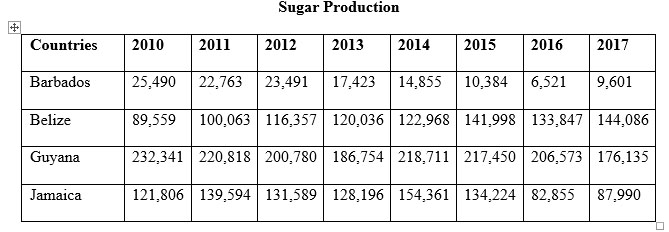Dear Editor,
One paused for some considerable time upon the appropriateness of commenting on the letter captioned ` Restoring the sugar industry to viability is not impossible’ published in your paper of August 18, 2020, one reason being that the writer has always abstained from what might be considered either a defence, or b) an ad hominem attack.
Apart from the fact that neither is a psychological approach to be embraced, one continues to be reminded of the Indian sage who says. There is nothing called ‘the truth’. There is only ‘a truth’.
Somewhere in the search there is factual history which certainly applies to the sugar industry to which all of us belong.
Please therefore be patient with this insertion:
“History recounts that sugar was being produced in what is now Guyana, as far back as the 17th century (evidence suggests as early as 1636), when the Dutch were involved, mostly in the Essequibo area.
In the 18th century (circa 1745) sugar plantations began to be established in Demerara; and by the early 19th century there were close to 400. Then through amalgamation followed a progressive reduction to 238 by 1829; 138 by 1890; 80 by 1900; 39 by 1922; 18 by 1967; 11 by 1976 – the year of nationalisation; then to 10 in 1978.
Factory operations were also reduced, being proportionately centralised – from 62 sugar factories in 1897 to 21 by 1928, and 10 in 1978 – almost identical with the concentration of the cultivations.
By the end of 2010 the disposition of grinding estates was as follows:
In Berbice – Skeldon Estate; Albion/Port Mourant (the latter half of the name memorialises the Port Mourant Estate which was closed in 1955); Rose Hall Estate – all east of the Berbice River; and Blairmont Estate on the western bank of the river.
On the East Coast of Demerara and immediately facing the Atlantic Ocean is Enmore Estate; La Bonne Intention (LBI)/Ogle Estate which also produces sugar from the canefields of the former Diamond Estate, (whose factory was closed in 1987). LBI/Ogle factory has since been closed, and all production concentrated at Enmore under the banner of East Demerara Estates.
On the West Bank of the Demerara River is situated Wales Estate; while along the West Coast of Demerara, and confronting the Atlantic Ocean, is Uitvlugt Estate, which produces sugar from cane grown at the neighbouring cultivation of Leonora Estate, whose factory was closed in 1986.”
What the above indicates is that more recent closures of estates were effected before the last administration.
Then there is the unsubstantiated irrelevance of retirees in the factory operations whose expertise was desperately necessary consequent upon the depletion of relevant skills on the estate locations. They therefore commuted to all the estate factories to attend to inherited deficiencies with which the various managements could not cope.
Regarding compensation it is worth emphasising that it was the administration of 2014 who contracted Hays Plc., highly respected international specialists in compensation management who recommended a comprehensive salary structure for GuySuCo which was approved by the Board of the day for implementation in respect of all non-unionised jobs. Those scales have not been adjusted since, and are still applicable in 2020.
With respect to comparabilities amongst counterpart industries in the Caribbean, the following Table may be of interest, in respect of sugar production:

The following are samples of more recent investment costs – up to year 2017:
Education and Training
a) Scholarships to the University of Guyana
2013-2017 – $12M
b) Scholarships to Guyana School of Agriculture
2010-2016 – $27M
C) Bursary Awards to children of employees
2010-2017 – $38M
d) Apprentice Training Centre
2010-2017 -$1.2Bn
e) Community/Industrial Welfare
2010-2017 -$850M
f) Pensions – 2010-2017
Contributory Scheme -$2.5Bn
Ex Gratia $5.8Bn
Not to mention the free medical services provided to all employees, spouses and unemployed children up to age 18, as well as pensioners.
Apart from the lack of water, it is certain that the island industries did not suffer from strikes comparable to GuySuCo.
Between 2010 and 2017 were recorded more than 1500 strikes, with man-days lost from work at an average of roughly 40 per year, and wages lost at an average of $119M annually.
Again, with respect to history, too few, if any, would have been aware of the fact that the awards of Holidays-With-Pay and Annual Production ‘Bonus’ (changed to ‘Incentive’ on nationalisation) were on the initiatives of the employers, with the eligibilities involving unionised employees being at work 75% and 82.5% of days respectively, of days made available for work.
This performance standard was subsequently adjusted during the first decade of this century in order to accommodate reduced attendance at work – consistently with the ‘theory of relativity’. Poor attendance continues to be the bane of under-achieving production targets, and is now a subject of negotiation.
This is not to say that the writer does not empathise with the view that the estate closures were peremptory and did not take sensitive consideration of the social and economic implications. To point out however, that the old culture of contentious industrial relations will have to be eschewed as a critical component of any redemption plan. All the unions must be required to be equal and productive partners if any reconstruction of our sugar industry is to be successful.
Ms. Thompson’s is a view that must be seen to ‘stir the pot’ of creativity past the instant pandemic (e) state.
Yours faithfully,
E.B. John





